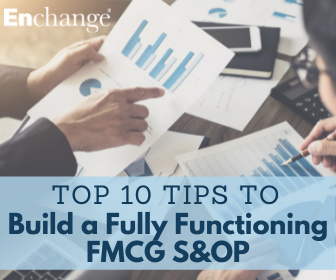The Enchange Supply Chain House; the one stop shop for all the elements you need to allow your supply chain to operate effectively. Now we take a deeper-dive look at what you need in place to obtain the best value from your overall Planning discipline. As described in the introductory Planning article, plan appears in every room in the Supply Chain House and rightly so. Today we are looking at the top 10 tips for a fully functional Sales & Operational Planning (S&OP) process.
 In successful FMCG and other companies, S&OP is the flexible glue that holds numerous processes together ensuring demand and supply are balanced along the chain and most importantly, everyone operates to the same set of unambiguous sales, volume and financial numbers.
In successful FMCG and other companies, S&OP is the flexible glue that holds numerous processes together ensuring demand and supply are balanced along the chain and most importantly, everyone operates to the same set of unambiguous sales, volume and financial numbers.
These tips assume you are already operating some sort of S&OP process. If S&OP is new to you then you should take 1 step backwards and seek assistance with the design and implementation of a robust process applicable to your business.
1. Demand Review
A forecasting and demand planning process focussed on customer requirements.
Does the review align the entire organisation in support of the business strategy? Does the Forecast & Demand Management process deliver a clear plan of unconstrained, expected sales. Do you use data inputs (e.g. Key Account POS, distributor sales out) from key supply chain partners? Do your sales incentive schemes bias the sales forecast? Is forecast accuracy reliably measured in order to continuously improve the process?
2. Supply Review
The process that provides the required customer service level by creating a plan for supplying the demand.Is this review the sole source of the requirements driving MRP/Scheduling & Supplier Planning? Is a reliable and consistent feedback mechanism in place to ensure bottlenecks and constraints are communicated in a timely manner.
3. Financial Evaluation
The financial implications of the outputs from the Demand and Supply Reviews.
Does the process use a cash-up rather than target-down approach? Is there one single set of numbers used by all functions within the supply chain, sales and finance for business planning? Does this evaluation provide all source data used for financial planning, reporting & measurement?
4. S&OP Consensus
The key S&OP process that sign-off the current operating plan in support of customer and company requirements.
Does the process include a formally minuted meeting proactively run by the CEO /General Manager? Is the planning horizon appropriate in order to plan company resources effectively? Do you include input and feedback from suppliers, distributors and other key partners?
5. Demand Execution
Control of the contact with the customer and generation of a sale within a clear Customer Service & Distribution Management process.
Are customer order capture and promise processes integrated with production plans, factory scheduling and inventory data? Do you have mechanisms in place to match orders to forecast and for handling abnormal demands? Are all orders given a clear promise date at order entry? Is Distribution Resource Planning (DRP) utilised to manage the logistics of physical distribution?
6. Supply Execution
The assured supply of finished goods perpetually managed to meet the output from the Supply Review.
Is there a Supplier Planning & Control Process providing visibility of key items availability over an appropriate planning horizon? Are all materials maintained at optimum inventory levels? Are SLAs established, performance measured and materials and finished goods maintained to policy levels?
7. S&OP Process Policy
A concise written S&OP policy that covers the purpose, process and participants.
Is this policy routinely updated to reflect organisational and personnel changes? Is the policy signed-off by the CEO/General Manager?
8. S&OP Process & Procedures
Ensuring you follow a living and breathing process and not a series of unrelated meetings.
Do you issue a flow or Gantt Chart showing the sequence of steps that must be followed and executed according to a timetable? Is the process fully supported by documented procedures?
9. S&OP Time Horizons
A fully constrained S&OP plan for an appropriate time horizon or period.
Are months 1 to 3 firm and endorsed by the sales department but with options to resolve constraints and challenges? Do you have an unconstrained rolling plan for months 4 to 6 defined by the marketing team? Is there a Supply Chain derived plan covering months 6 to 12, at least?
10. Innovation/New Product Development
A review of the progress of strategic projects and brand/supply chain innovations.Is NPD resource allocated effectively and takes cost, time and head-count into account? Is the NPD schedule reviewed in the Demand meeting and against an appropriate rolling time horizon?
S&OP has been shown to make dramatic differences within reasonably short time periods in thousands of companies. This success is not limited to blue-chip global players but many progressive regional and local operations have seen sales increase and costs reduce. Addressing tips 1-10 in a disciplined process will allow your FMCG company to share in that success.
Read more articles on Supply Chain Excellence and Route To Market on our website where you can also subscribe to our updates.
Finally, feel free to use any of our contact routes including Live Chat, if you have any questions about how the Enchange Supply Chain House can assist your journey to supply chain excellence.







